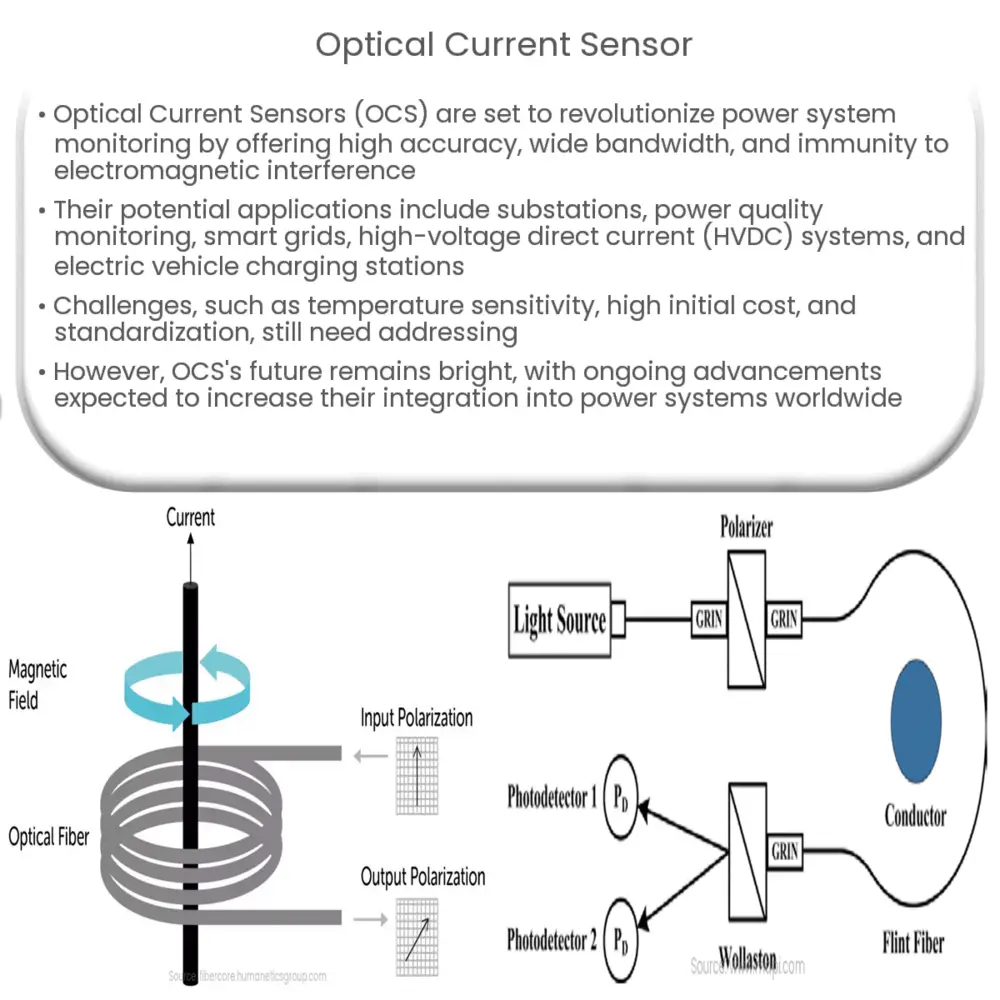Optical Current Sensors offer accurate, wide bandwidth current measurement, with galvanic isolation and EMI immunity for power system monitoring.

Optical Current Sensor: The Future of Power System Monitoring
Introduction
As the demand for electricity continues to grow, power systems around the world are becoming more complex, requiring sophisticated monitoring and control technologies. One such technology that has gained significant attention in recent years is the Optical Current Sensor (OCS). These sensors are transforming the way we measure and monitor electrical currents, offering numerous advantages over traditional current transformers. In this article, we will explore the principles behind OCS, its applications, and its potential impact on power systems worldwide.
Principles of Optical Current Sensing
At the heart of an Optical Current Sensor is a principle known as the Faraday Effect, a phenomenon in which the polarization of light changes as it passes through a magnetic field. The magnitude of this change in polarization is directly proportional to the strength of the magnetic field and the amount of current flowing through the conductor. By measuring the change in polarization, it is possible to accurately determine the current flowing through the system.
In an OCS, an optical fiber is wrapped around a current-carrying conductor. As the light travels through the fiber, it is affected by the magnetic field generated by the current in the conductor. The change in polarization is then detected by a photodetector, which converts the optical signal back into an electrical one. This electrical signal is then processed and analyzed to determine the magnitude of the current flowing through the conductor.
Advantages of Optical Current Sensors
Optical Current Sensors offer numerous advantages over traditional current transformers, making them an attractive choice for modern power systems. Some of the key benefits include:
- Accuracy: OCSs provide high accuracy over a wide range of currents, from low to high values, making them suitable for various applications in power systems.
- Wide bandwidth: Unlike traditional current transformers, which can suffer from saturation and distortion at high frequencies, OCSs have a wide bandwidth, allowing them to capture fast transient events and harmonics effectively.
- Galvanic isolation: Optical fibers are made of dielectric materials, which means that they do not conduct electricity. This provides excellent galvanic isolation, reducing the risk of electrical faults and improving overall system safety.
- Compact and lightweight: OCSs are typically smaller and lighter than traditional current transformers, making them easier to install and integrate into existing power systems.
- Immunity to electromagnetic interference: The optical nature of the OCS makes it immune to electromagnetic interference, ensuring accurate and reliable measurements in electrically noisy environments.
In the second part of this article, we will discuss the various applications of Optical Current Sensors in power systems, as well as the challenges and future prospects of this emerging technology. Stay tuned!
Applications of Optical Current Sensors in Power Systems
Optical Current Sensors have a wide range of applications in power systems, including:
- Substations: OCSs can be employed in substations for accurate current measurement, protection, and control. Their high accuracy and wide bandwidth make them suitable for detecting faults, enabling quick response to prevent equipment damage and ensure grid stability.
- Power quality monitoring: The ability of OCSs to capture harmonics and fast transient events makes them ideal for power quality monitoring. They can be used to identify and diagnose issues such as voltage sags, swells, and flicker, helping to maintain optimal grid performance.
- Smart grid applications: With the increasing integration of renewable energy sources and distributed generation, OCSs can play a crucial role in monitoring and controlling these resources, ensuring efficient and reliable operation of the power grid.
- High-voltage direct current (HVDC) systems: OCSs are well-suited for HVDC systems, as they can withstand high voltages and provide accurate measurements without the need for additional voltage dividers or potential transformers.
- Electric vehicle charging stations: As the adoption of electric vehicles continues to grow, OCSs can be used in charging stations to monitor and manage the flow of electricity, ensuring safe and efficient charging.
Challenges and Future Prospects
Despite the numerous advantages and promising applications of Optical Current Sensors, there are still some challenges to overcome. Some of these challenges include:
- Temperature sensitivity: The performance of OCSs can be affected by temperature variations, which may cause measurement errors. Future developments in temperature compensation techniques and materials will help to mitigate this issue.
- Cost: The initial cost of OCSs can be higher compared to traditional current transformers. However, as the technology matures and economies of scale come into play, it is expected that the cost will become more competitive.
- Standardization and certification: As a relatively new technology, OCSs still require standardization and certification processes to ensure consistent performance and interoperability with other components in the power system.
Despite these challenges, the future prospects for Optical Current Sensors are bright. With continued advancements in materials, manufacturing techniques, and signal processing algorithms, it is expected that OCSs will become increasingly integrated into power systems worldwide. As the demand for more efficient, reliable, and safe power systems grows, the adoption of OCS technology will play a crucial role in meeting these needs and shaping the future of power system monitoring and control.
Conclusion
Optical Current Sensors represent a significant leap forward in power system monitoring and control, offering a range of advantages over traditional current transformers. With applications in substations, power quality monitoring, smart grids, HVDC systems, and electric vehicle charging stations, OCSs are poised to play a critical role in the future of power systems. As the technology continues to evolve and mature, overcoming challenges such as temperature sensitivity, cost, and standardization, we can expect to see Optical Current Sensors become an integral part of modern power systems worldwide.

